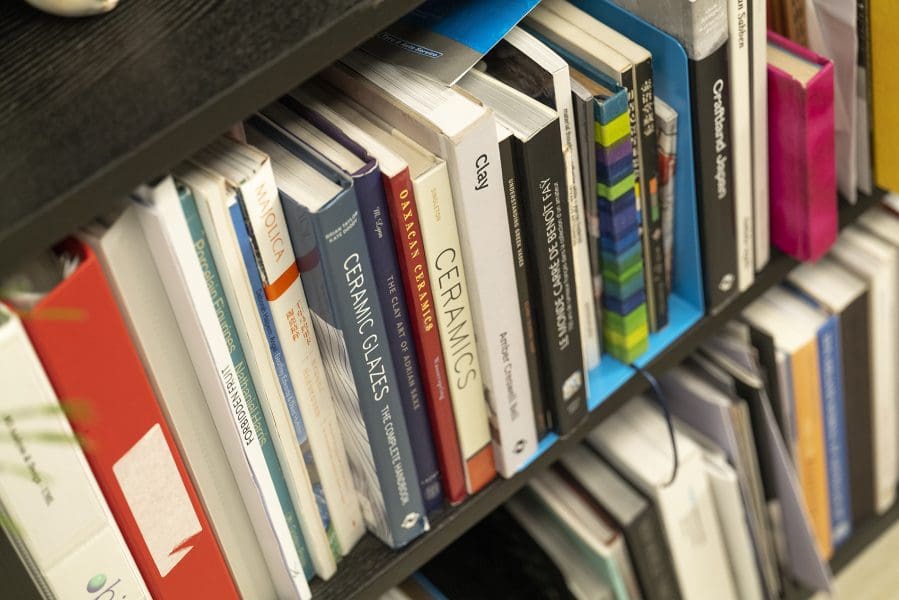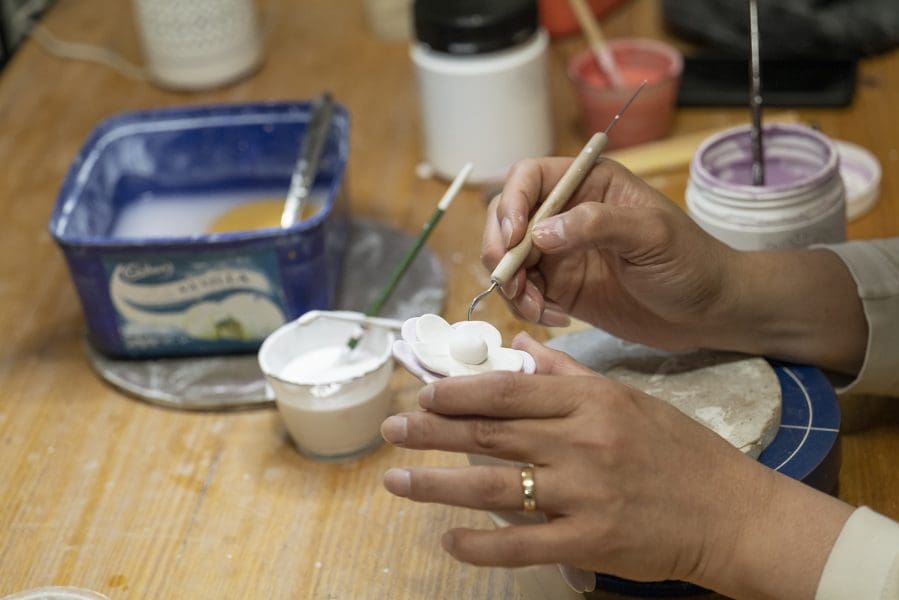
Making Space at the Table
NAP Contemporary’s group show, The Elephant Table, platforms six artists and voices—creating chaos, connection and conversation.
Ceramicist Vipoo Srivilasa has a penchant for intricate and layered decoration that, he explains, is influenced by the ornate Buddhist temples he encountered growing up in Thailand. With an aesthetic he cheerfully describes as “more is more,” Srivilasa’s distinctive work also draws on European historical figurines and “a healthy dose of contemporary culture”. We chatted over cups of sencha tea in Srivilasa’s clean, bright warehouse studio in the suburb of Cheltenham, in Melbourne’s south-east.
Place
I’ve made this space really comfortable because I spend most of my time here, almost seven days a week. I come here about 7:30 in the morning and leave at 3:30 in the afternoon, go home, and do some shopping. Then I work on the computer, like writing or administration, in the evenings. Most of the time I’m just here; I live 10 minutes from here, so it’s really easy. Sometimes I go home for lunch—but I’ve found it kind of distracting, like you go home and it’s hard to come back again. So I bring my own lunch, or I’ll walk around the corner for a Vietnamese lunch.
I used to have a studio in St Kilda, a shared studio. But then I bought a kiln and there was no space, so I had to find a place to work. I was looking for someplace near my house and there was nothing for rent—and someone suggested, “Why don’t you buy it?” Because back then, the monthly rent and the mortgage were almost the same; not the same, but close. I thought—I might just do it! Now I work alone, and I can do anything I want to the space. It’s just really, really good. This is my fourth year here.

Process
I do a lot of sketching at home but, more and more, I try to do things here, just to separate the space. I normally use porcelain clay. It fires to 1200 degrees, so I get that real whiteness that goes really well with the blue colour I use.
Recently, since the Covid lockdown, I feel like I have to reinvent myself. It’s just the pressure that I put on myself: I feel like now everybody is starting from zero, and everything depends on how you’re going to emerge from the lockdown, and if you’re going to be just where you are, or you’ve become a butterfly. And I want to be a butterfly!
I’ve invested in doing a lot of different things, experimenting. One thing I did is using colour on my work, so now I use less and less blue and white colour, but I use a lot more brighter colours. It actually is really hard because there’s so many choices! The blue and white, when you just have two colours, you just play with the tone, with the texture, with the patterns—but now you have endless choice.
I’ve got a lot of projects that were pushed from last year. I’d spread it out really nicely, but everybody had to postpone: the first half of this year, this is the time that they’re free, take it or leave it. So it’s just like, “Okay, I’m doing it.” It’s actually really, really crazy. I was like, “How do I do this?” But I’m very organised, and I plan way in advance. I think I can cope with this.

I have five galleries representing me: three in Australia, one in London and one in Bangkok. So that keeps me quite busy as well…but I think planning ahead helps a lot. And I think that’s how I can survive as a full-time artist, because if the one in London doesn’t sell well, then maybe the one in Bangkok will sell really well. It’s not putting all my eggs in one basket—I have five different baskets.
I think that has made me understand the business side of art as well. I’m not just making art for art’s sake—it’s my full-time job, it’s how I make a living. I have to balance what I want to make. Luckily, what I make is kind of what people like! I can somehow walk the fine balance between the business world and the art world, and also the craft world. I somehow navigate through these quite okay.
You know, someone told me a long time ago when I first started, “Being an artist—it’s not easy. But if you stay long enough in the field, you will be recognised.” And I just didn’t understand that at all, when I first started. I just thought, like, “Oh, it’s just about how good your work is.” But then after 10, 15 years of being a full-time artist, I realised that is actually true— because when I first started, you know, I saw many ceramic artists that—I wouldn’t say competed, but we entered the same shows, we got shortlisted together, we got selected in these group shows all around the country and we were seeing each other’s work for a while. And then slowly they all kind of dropped away—I just don’t see that work anymore. I slowly realised, “Oh yeah…being a full-time artist is not just making good work.” There’s a lot of other things around it to make you last longer.

Process
For the show at Warrnambool Art Gallery (WAG) I’m fixing broken ceramic pieces for people, to repair happiness or ‘re-joy’. We asked the local community to donate objects, and I gave Aaron [Bradbrook, curator of WAG] a task to do: I asked him, “Okay, you have to choose seven particular broken ceramics that affect your emotions, and then bring it to me and tell me why you’ve chosen it. And then I’m going to repair it.”
The objects are all sort of different things that I didn’t think I would get—a pot that has been dug up from the land, figurines, religious objects.
I was thinking maybe a cup, a bowl, but actually no. When I saw the work and the stories that come with the pieces I was like, “Oh man, it’s so good that I just said seven pieces!” The work is really elaborate, and the stories that come with the work are really, really meaningful and also quite touching. And now it’s kind of a burden for me! Like, how can I make the work live up to the story that comes with the piece? It is quite stressful, more than I thought it would be—but it will be a fun challenge.
I think each piece will be repaired with different processes, depending on the story coming with the piece. Some of the pieces I can see what it is going to be, but some, I just need time to sit with it.
I’ve done a lot of community projects before, but not this involved—and not involving the curator as my gatekeeper. Having Aaron involved, it’s really changing the perspective of the whole project and of the objects as well.
Aaron said something quite important too. He said, “This project is for people that are in a particular time and space that they are actually ready to let the object go.” So not everybody would come in with the object and let it go. You have to have someone who, at that particular time, is ready to let go of the object; and come to be part of this project.
Re/JOY
Vipoo Srivilasa
Warrnambool Art Gallery
1 May—20 June
Wellness Deity
Vipoo Srivilsa
Linden New Art
22 May—22 August
This article was originally published in the May/June 2021 print edition of Art Guide Australia.